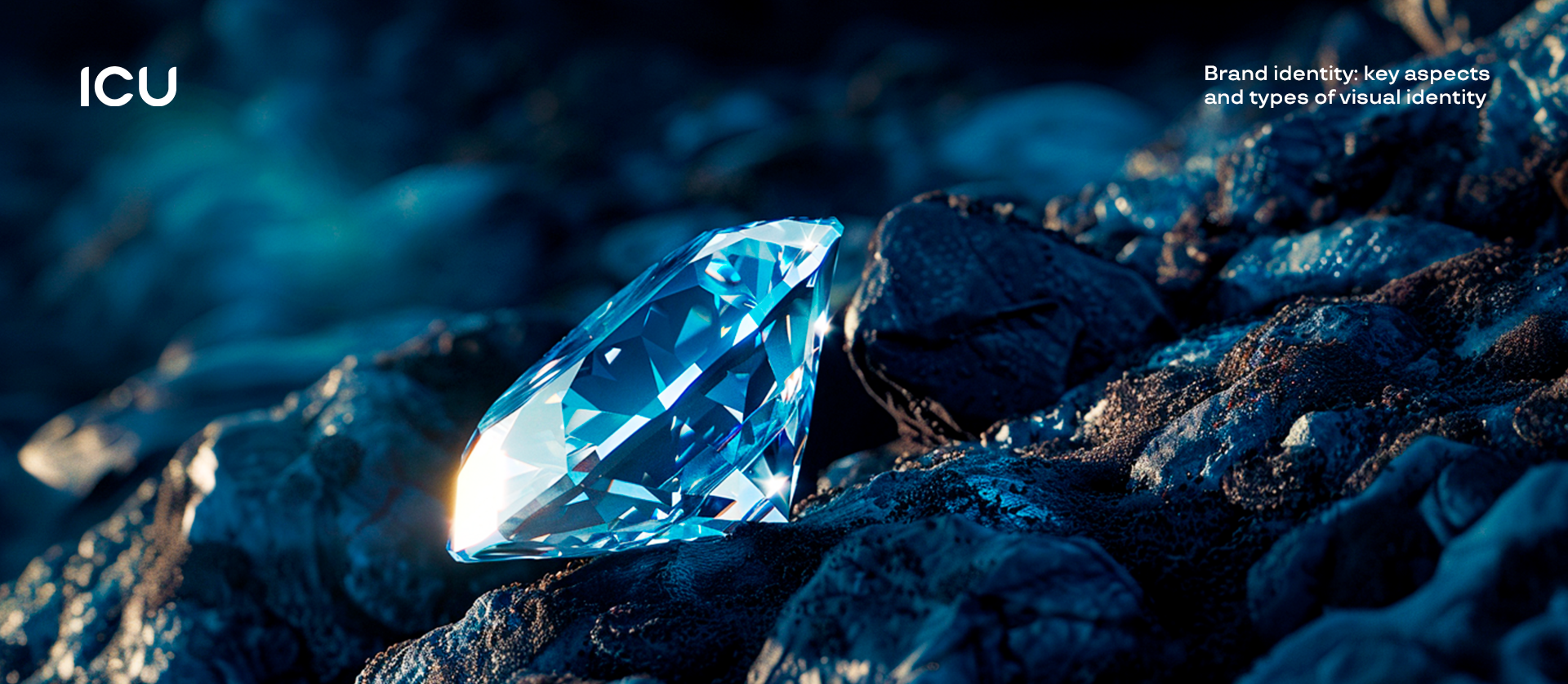Brand identity: important characteristics and types of visual identity
 ICU Branding agency
ICU Branding agency
What’s the connection between Disney typography, mascots like the Red and Yellow M&Ms, and the turquoise Tiffany box? All of the components of brand identity are there. Quality is no longer seen as a default characteristic and is insufficient for a brand to succeed. Effective marketing is essential, and it all begins with visual identity.

This discourse will cover the definition, components, and creation process of brand identity in design.
What is brand identity?
All of a brand’s distinguishing features on the outside are included in its brand identity. First and foremost, there is the logo. Brand identification refers to the characteristics that help us identify a brand.
The color, typeface, and logo of Google and Yandex’s opening pages make it quite clear which search engine you use.

The Significance of Brand Identity
Corporate identity, whether it be a logo on a vehicle hood, the owner’s business card, or the layout of a website in a corporate style, establishes a distinctive picture of a firm through a combination of colors, typefaces, and visuals across any medium. In addition, corporate identification is the most reliable indicator of authenticity when it comes to counterfeit goods.
Brand identification frequently goes beyond visual components because a brand may be recognized using all five senses. As a result, touch, taste, smell, hearing, and sight can all be impacted by brand identification.
Everything visible is included in the visual component, such as the pictures, colors, and logo.
Additionally, there is identifiable music, trademarked sounds, or even how staff members converse. This is what audio identity is all about. Do you recall the catchphrase “Holidays are Coming” from Coca-Cola? You must have hummed along. Or Tarzan’s Cry, which is copyrighted by Edgar Rice Burroughs Inc. and is made by actor Johnny Weissmuller.
It is quite uncommon to come across a brand identity that establishes a taste link with the brand. Ikea’s signature taste, meatballs with sweet sauce, is one example.
The cost of standing out through scent is high. By spreading scents throughout their facilities, hotels usually employ “aroma identity” to help customers identify the scent of the hotel brand. Porsche purposefully adds a unique wood fragrance to the inside upholstery.
Brand identity affects touch as well. This typically uses packaging, business card paper, and jewelry box materials.
Thus, a corporation may simultaneously accomplish many goals through brand identity:
1. Builds a strong brand in the marketplace and “compels” the customer to recall it, establishing a long-lasting connection with the business so that the consumer may select the one with the desired brand’s identity when faced with various options.
2. Embodies the brand’s positioning, principles, and character. This establishes a sentimental bond with the customer. In the end, this strengthens brand trust and client loyalty.
3. Shows the theme group the brand is associated with. For instance, fast-food chains frequently use vibrant colors like red or yellow.
Finding the standard colors for a niche also aids in the other way, totally differentiating oneself from rivals and developing an entirely original style.
4. Creates a network of people that includes corporate employees and brand enthusiasts. For instance, Greenpeace emphasized its mission of environmental protection by selecting the color green for its brand identification. Green has evolved to represent the eco-idea, and now, many forms of green represent how companies and individuals with similar environmental and climate change concerns may join together.

Brand style and identity are not the same.
A brand’s colors, typefaces, styles, shapes, images, and patterns are all part of its overall style. However, brand identity is a more comprehensive idea that governs the application of the brand style across a range of media. In addition to visual cues, brand identity engages the customer through additional senses.
“We’ve designed a script font with spirals and a bright red color, defined the shade of the color and the tilt of the curls in our brand guidelines,” the owner of Coca-Cola, for instance, would explain to you.
He says to you, “Describe to me how this will appear on a bottle and other mediums.” Additionally, you create mock-ups of business cards, product packaging, and holiday truck décor ideas.

When is brand identity necessary?
Is brand identity really necessary at all? Most likely not if you own a tiny corner grocery shop. Yes, if your goal is to become known outside of your local area.
· Establishing a new branch, expanding your brand, or growing your business all require a strong brand identity. These actions will help establish a distinctive picture of the business from the first.
· Aiming for a single, cohesive look by unifying everything from employee attire to signs.
· Increasing sales to a new level: a strong brand identity can assist draw in more clients even if your product is excellent.
· Entering new markets requires modifying your media to fit the mindset or cultural quirks of the target nation.
· Changing the brand identity and developing a new corporate image will make the organization appear more interesting and current as well.
· Putting a focus on your brand identity and unique selling proposition (USP) will help your message reach the intended audience.
In summary, developing a brand identity is something you should think about if you want to expand your company in any way.
What does brand identity consist of?
An picture created by a brand identity may be dissected into its constituent parts. Brand identity consists, at the at least, of a logo, typography, and color. The maximum number of components, however, can be much higher:
· Naming
It should ideally have an accessible domain, be comprehensible, and have an unique domain. Next, you must ascertain its declensions, permissible languages, and spelling.
· Logo
You’ll need a number of selections in various formats and resolutions, both in color and black and white. You’ll have versions that are adaptable to any media in this way.
· Fonts
If there are many fonts, it’s crucial to indicate which ones to use for each situation as well as the font sizes, margins, and line spacing.
Acceptable font sizes, colors, and spacing are listed in the Airbnb brand guidelines:
· Colors
Precise shade matching and printing-specific numbers and codes must be followed.
What if you downloaded the Sberbank app with a khaki tone instead of the company’s signature, life-affirming green? You would assume it is a fake, for sure.
· Backgrounds:
If you have particular patterns, describe them in detail, including color combinations and the situations in which they should be used.
· Illustrations
Every illustration, picture, symbol, site component, and business mascot are also included in the brand identity. It’s important to decide on the colors, styles, and methods that can be used.
Types of brand identity: Static and Dynamic
Static and dynamic categories are typically used to categorize brand identities.
A timeless design is a static brand identity. Stated differently, these are characteristics that remain constant throughout the brand’s history. These might be logos, colors, or typefaces. Establishing a recognized image and long-lasting links with the brand is the aim of this kind of identity.
Hollywood veteran Metro Goldwyn Mayer, which has stuck to its chosen image — the roaring lion within the filmstrip “frame” — for 108 years since its foundation, is an example of a static corporate identity.
A flexible kind of identity is dynamic brand identity. It adjusts to market trends, varies according on the context in which it is used, and keeps the brand’s contemporary image.
Melbourne’s unique city character is a great illustration. The adaptable logo produces a recognized design for a variety of uses, surfaces, and urban environments.
Because they may be combined for a single brand, both forms of brand identification are noteworthy. For instance, the logo may have a dynamic design yet a static form.
Phases involved in creating a brand identity
Before getting right into developing a brand identity, a few steps must be finished:
· Analyze your target audience to determine what problem your brand identity should be solving for them.
· Analyze rivals’ brands to find ways to set yourself apart from them.
· Communication points with the intended audience: Determine the channels and platforms you use to interact with customers.
· Big Idea: decide what feelings you want to arouse in people, what associative connections to make, and what core message you want to express through your brand identity.
· Determine whether the design may incorporate an innovative aspect as part of its Unique Selling Proposition (USP).
· Create basic visuals and symbols for your logo that may be used into your brand’s identity.
· Choose a color scheme that will assist elicit the appropriate connection and emotional reaction from the buyer.
· Typography: Choose a font family that complements your objective.
You should only move on to adapting the complete concept to certain mediums after finishing these steps.
Examples of ICU brand identities
The ICU team used the picture of a ship with a shield in front of it as a protective symbol when creating the brand identity for the maritime transportation insurance firm, RO maritime. We used the Norwegian flag’s colors when developing the brand to represent national symbolism. Furthermore, we reflected the following in the dynamic nature of the essential element: RO will defend the business and steer it in the proper direction no matter what turbulence arises.
We considered the requirement to communicate innovation in the new campaign while developing the brand identity for the tire company Nokian Tyres. This brought us to the notion of extraterrestrial technology, which served as the foundation for the style.

Subscribe to my newsletter
Read articles from ICU Branding agency directly inside your inbox. Subscribe to the newsletter, and don't miss out.
Written by

ICU Branding agency
ICU Branding agency
Branding agency that creates a connection between business and audience through in-depth research and creative thinking.